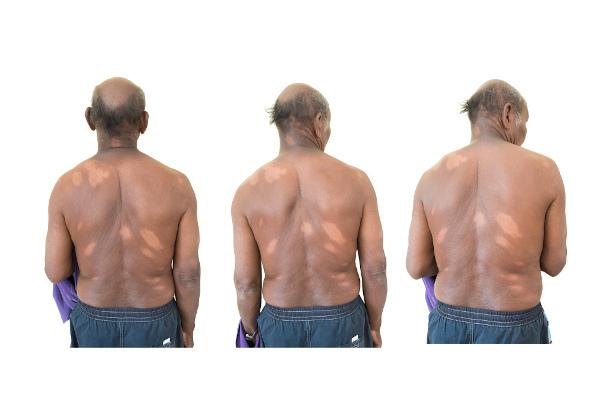THE leprosy it is one of the oldest diseases we know, with some records dating it to 600 BC. Ç. Is chronic and infectious disease caused by a bacterium call Mycobacterium leprae, that affects skin and nerves peripherals. Below, we will learn more about leprosy, its form of transmission, its causative agent, its types, symptoms and treatment.
Read too: Leprosy: the oldest disease in the world
What is leprosy?
Leprosy is a chronic disease, that can be transmitted from one person to another and that presents as an etiological agent a bacterium, O Mycobacterium leprae, known as Hansen's bacillus. This pathogen, identified by the Norwegian physician Gerhard Henrik Armauer Hansen, belongs to the order Actinomycetals and the family Mycobacteriaceae, and its size is around 1 µm to 8 µm in length and 0.3 µm in diameter.
Hansen's bacillus acts by affecting the skin and peripheral nerves. As a result, the disease leads to skin lesions with changes in sensitivity and also problems related to muscle strength. If not treated early, it can lead to serious and often disabling complications.

Leprosy Transmission
Hansen's bacillus stands out for being able to infect a large number of individuals, however, few of those infected actually get sick, which means that it presents low pathogenicity.
The disease is transmitted, from one person to another, when the patient eliminates the causative agent, mainly through the upper airways. Contact with the patient must be direct and prolonged for transmission to occur.
The transmission of leprosy occurs mainly through patients called multibacillary, which have a large bacillary charge. Paucibacillary patients (with lower bacillary load) are not considered an important source of transmission.
Another important point to be highlighted is that, right at the beginning of treatment, the person stops transmitting the disease.
Types of leprosy
Leprosy patients are classified according to the World Health Organization, in two groups: paucibacillary and multibacillary. Those are the ones with exams with few or no bacillus; on the other hand, these are the ones that present a lot of bacilli in their exams.
According to the Madrid classification, leprosy can be classified into: indeterminate (paucibacillary), tuberculoid (paucibacillary), borderline (multibacillary) and lepromatous (multibacillary) leprosy. See the definition of each of these types, according to the Brazilian Society of Dermatology:
Undetermined: Patients have up to five patches of imprecise contours, and, in this case, there is no neural impairment. It is the initial stage of the disease.
Tuberculoid: Patient has up to five well-defined lesions and one compromised nerve.
Dimorphous: The patient has more than five lesions, with edges that may be well or poorly defined, and involvement of two or more nerves.
Virchowian: The patient has the most widespread form of the disease, with a large part of the damaged skin being observed and, sometimes, involvement of organs such as the nose and kidneys.
Read too: Bacteria present in the human body - macrobiota formation
Leprosy symptoms
Leprosy is a disease that, as said, affects the skin and peripheral nerves, so its symptoms are related to the involvement of these areas. Without a doubt, one of its most striking manifestations is the patches on the skin that have altered sensitivity, however, this is not the only symptom.
See below the main signs and symptoms observed in leprosy patients:
Spots (whitish, brownish and reddish) on the skin with changes in pain sensitivity, thermal and tactile;
Pinching sensation, shock, numbness and tingling along the path of the limb nerves;
Hair loss in some areas and reduced perspiration;
Dry skin;
Swelling in hands and feet;
Swelling and joint pain;
Reduced muscle strength where nerves were affected;
Pain and thickening in peripheral nerves;
Lumps on the body;
Eyes dried out;
Nose sores, bleeding and dryness;
Fever and general malaise.
Complications of leprosy
Leprosy, if not treated initially, can progress to physical disabilities. Between the sequelae left by the disease are:
Inability to lift the foot (“foot drop”);
Inability to extend fingers and wrist (“dropped hand”);
Inability to close the eyes (lagophthalmos);
Necrosis and ulceration of the cartilage of the nose (“sagging nose”).

Leprosy diagnosis
The diagnosis of leprosy is made basically by analyzing the clinical manifestation of the disease. In addition, the exam called Intradermal smear smear microscopy is used in order to confirm it. This test aims to identify the presence of bacilli. It is noteworthy that the negative test result does not rule out the disease if the patient presents symptoms.
Leprosy treatment
Leprosy is a disease that is currently curable. In the past, the sick person was isolated from society, and the disease, considered a punishment, was associated with sin and impurity. Today, however, that has changed and the patient can continue his treatment at home.
The treatment of leprosy is done through the polychemotherapy (MDT), which consists of the association of several antimicrobials. This treatment is provided free of charge by Health Unic System, and the patient is not hospitalized. It guarantees the complete cure of the disease.
Did you know that, since 1976, in our country, the term leprosy (an old name for leprosy) should no longer be used? This measure was adopted because the term carries a sad history of prejudice. |
Read too:Correct use of antibiotics - bacterial resistance and consequences
National Day to Combat and Prevent Leprosy
In Brazil, in last sunday of january, commemorates the National Day to Combat and Prevent Leprosy. The date was established by law No. 12,135, of December 18, 2009. The last Sunday in January is also the World Day Against Leprosy.
Since 2016, the Ministry of Health has made January official the period for combating leprosy, and set the color purple for the educational campaign. Therefore, the month of January was renamed January purple and is dedicated to awareness of the disease.
By Vanessa Sardinha dos Santos
Biology teacher
